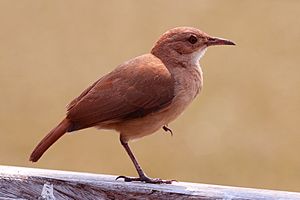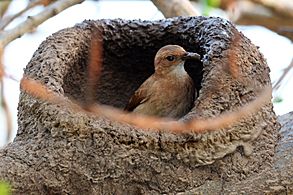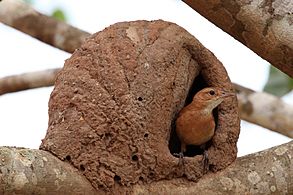Rufous hornero facts for kids
Quick facts for kids Rufous hornero |
|
|---|---|
 |
|
| Rufous hornero in Pantanal, Brazil. | |
| Conservation status | |
| Scientific classification | |
| Kingdom: | |
| Phylum: | |
| Class: | |
| Order: | |
| Family: | |
| Genus: |
Furnarius
|
| Species: |
F. rufus
|
| Binomial name | |
| Furnarius rufus (Gmelin, 1788)
|
|
The rufous hornero (Furnarius rufus) is a medium-sized bird. It belongs to a family of birds called ovenbirds. You can find it in eastern South America. This bird is so special that it is the national bird of Argentina.
People also call it the red ovenbird. It likes to live in open areas like savannas, farmlands, and even city suburbs. This bird lives in southeastern and southern Brazil, Bolivia, Paraguay, Uruguay, and northern and central Argentina. It can even be found as far south as northern Patagonia. The rufous hornero is closely related to the crested hornero. There are four different types, or subspecies, of the rufous hornero.
The rufous hornero is a medium-sized bird. It has a square tail and a bill that curves slightly downwards. Its feathers are mostly reddish-brown. The top of its head is a dull brown, and its throat is whitish. Male and female horneros look very much alike. Young birds are a bit lighter in color. Rufous horneros eat insects and other small creatures like arthropods. They find their food by walking on the ground. Sometimes, they even eat small bits of food like bread crumbs.
When rufous horneros sing, the male and female sound a bit different. They often sing a fast, trilling duet. The male's trill is faster than the female's. While singing, both birds flap their wings at their sides. Their wings beat at the same speed as their trill. So, if you watch them, you can tell if it's a male or female by how fast their wings flap!
What Eats Them?
Some animals hunt rufous horneros. These include birds that hunt, like the black-chested buzzard-eagle. Small mammals and even domestic cats can also be predators. Different types of snakes and possibly lizards might also hunt them. However, the hornero's special covered nest helps protect its eggs and young from danger.
Reproduction and Life Cycle
Rufous horneros lay their eggs in the summer in the southern part of the world. This happens between August and December. The young birds hatch soon after. They might stay in their parents' territory until the next breeding season. These birds are monogamous, meaning they stay with one partner. Their pair bond lasts a long time, sometimes for their whole lives.
The hornero's nest is very unique. It's a large, thick "oven" made of clay. They build these nests on trees, fenceposts, telephone poles, or buildings. The male and female work on the nest together all year long. A nest can be built in as little as 5 days. But usually, it takes longer, sometimes even months, to finish.
A female hornero usually lays two to four eggs. She lays one egg every other day. The parents then sit on the eggs for 14 to 18 days to keep them warm. The baby birds are fed for about 23 to 26 days before they can fly. Young birds stay with their parents for about 6 months after they learn to fly. Sometimes, they stay until the next breeding season. Both parents help incubate the eggs and feed the young. Horneros might not use the same nest again. So, you might see several nests close together, or even on top of older nests, in the same area. But sometimes, they will fix up an old nest to use again.
How Are They Doing?
The rufous hornero has actually done well because of human changes to the environment. Many of them now live in places changed by people, like city suburbs. When horneros leave their nests, other birds can use them. For example, the saffron finch often nests in old hornero "ovens."
The rufous hornero is a common sight in many places where it lives. It has become the national bird of Argentina and Uruguay. Human activities do not threaten this bird. The IUCN says it is of least concern. This means it is not in danger of disappearing.
Images for kids
See also
 In Spanish: Hornero común para niños
In Spanish: Hornero común para niños





